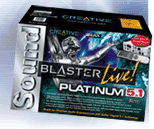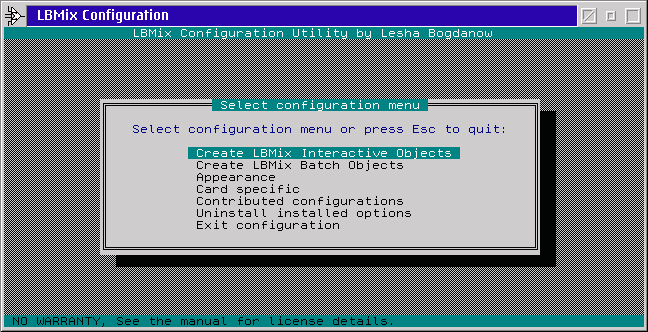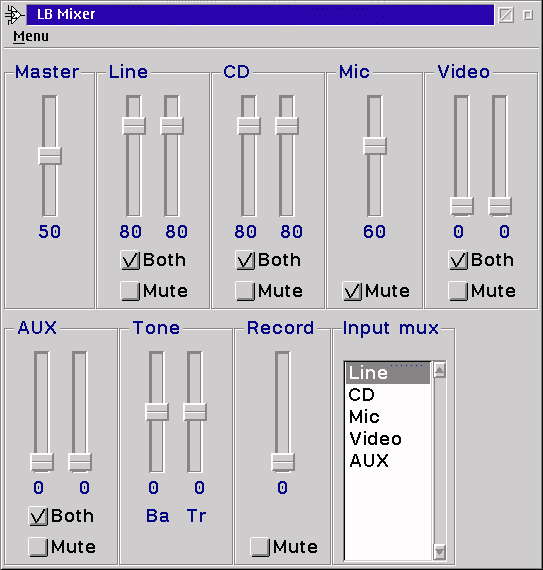
16 July 2001
Robert Basler is the president of Aurora Systems, Inc. and a dedicated OS/2 user since he tired of rebooting Windows 3.1 twenty times a day.
If you have a comment about the content of this article, please feel free to vent in the OS/2 eZine discussion forums.
There is also a Printer Friendly version of this page.
|
Previous Article |
|
Next Article |

SoundBlaster Live! Platinum 5.1
 Recently I thought it was time to update my old SoundBlaster AWE 64 sound card to something with 4 channel sound and some extra inputs. My big problem was that the MPEG2 decoder card and the WinTV card both wanted to connect to the SoundBlaster AWE 64's single line-in jack. Crawling under my desk to switch connectors was getting a bit tiresome.
Recently I thought it was time to update my old SoundBlaster AWE 64 sound card to something with 4 channel sound and some extra inputs. My big problem was that the MPEG2 decoder card and the WinTV card both wanted to connect to the SoundBlaster AWE 64's single line-in jack. Crawling under my desk to switch connectors was getting a bit tiresome.
About the Live!
The SoundBlaster Live! card comes with a number of standard connectors. On the back panel are: Line In, Line Out (Speakers), Microphone In, Digital Audio out (for digital speakers), Rear Speakers out and Joystick. Internal connectors include CD-ROM analog audio, CD-ROM/DVD digital audio, AUX input, and Telephone Answering Device (mono). I would like to have seen separate speaker and line out jacks, but that's the way it goes.Platinum Features
I opted for the Platinum version which comes with a lot of extra goodies including the Live! Drive, a panel that fits in a standard 5-1/4" drive bay and offers a wide variety of additional in and out connectors including optical in and out for connection to an external DVD or AC3 decoder/amplifier, digital SPDIF in/out, headphone and microphone (both 1/4" plugs, both with volume control dials,) MIDI in/out and an additional analog line-in with left and right RCA plugs. Note that there are three versions of the Live! Drive, the one described here is the Live! Drive IR, the other ones have fewer connectors. The Live! Platinum also includes an infra-red remote control for use with the Creative Labs Windows software and four full Windows games including Deus Ex, Unreal Tournament, Thief II, and MDK2. Unless you need the additional connectors, I would recommend the plain SoundBlaster Live! at about 1/3 the price of the Platinum version.
Installing the Card
 The SoundBlaster Live! is a half-length PCI card. If you have a Plug and Play system, with any luck the card should be detected and configured correctly. For me there were some additional steps. My PCI network card doesn't like to share interrupts. I've had problems with it before. Installing the Live! next to the NIC caused my BIOS to assign them both the same interrupt. This resulted in the Live! playing the first bit of the startup sound over and over and over until I shut OS/2 down.
The SoundBlaster Live! is a half-length PCI card. If you have a Plug and Play system, with any luck the card should be detected and configured correctly. For me there were some additional steps. My PCI network card doesn't like to share interrupts. I've had problems with it before. Installing the Live! next to the NIC caused my BIOS to assign them both the same interrupt. This resulted in the Live! playing the first bit of the startup sound over and over and over until I shut OS/2 down.
The documentation suggested turning the "Plug and Play Aware OS" setting in the BIOS off, but that didn't make any difference. The solution in the end turned out to be to move the card to a different PCI slot.
SoundBlaster Live! OS/2 Audio Driver 0.7
Creative Labs gained a somewhat poor reputation among OS/2 users after dropping support for OS/2 around the time the SoundBlaster AWE 64 was released. Not too long ago, Creative Labs made Linux open-source drivers available for the SoundBlaster Live!. One ambitious OS/2 programmer, Sander Van Leeuwen took up the project and has produced drivers available from the OS/2 Netlabs with some very nice features.Installing the Drivers
The drivers come with a simple install utility, to get the drivers set up, you just need to run it. One little gotcha to watch out for is when the OS/2 Multimedia Installer starts, look at the buttons at the bottom of the dialog. If the far right one doesn't look right, (SDD users will probably see this) you need to move the installer window off to the right of the screen until the button isn't visible, then click the install button. If you try to install with the corrupted button onscreen, the installer will crash.Some users have run into a bit of trouble with some remnants of their old sound card drivers in \MMOS2\MMPM2.INI, the central configuration file for OS/2's multimedia systems. One BIG word of advice here, MAKE A BACKUP OF MMPM2.INI BEFORE YOU START CHANGING IT. If you make a mistake, OS/2 will boot as far as a blue screen, then stop. Once you have made a backup, open MMPM2.INI using E or your favourite ASCII editor. Make whatever changes you need to, then give them a go.
The Live! Experience
Once the Live is installed and running, you'll find it has some very nice features. First of all, the rear speakers come alive, filling your computer room with sound. Next, you'll discover that the Live! supports up to 32 simultaneous wave outputs at a time, so that if one program makes a sound while another, like an MP3 player is running, the sound just happens, it doesn't cause the first one to stop, play the second sound, and then restart. This is a big improvement over older SoundBlaster cards.The Generic WinOS/2 Audio Driver
Once you have sound working in OS/2, it is time to add support for sound in WINOS/2. Installing the Generic WinOS/2 drivers is easy, a couple of changes to CONFIG.SYS and the \OS2\MDOS\WINOS2\SYSTEM.INI file and a few simple file copies and the drivers are ready to go.The drivers work well, especially compared to previous WinOS/2 SoundBlaster drivers which demanded exclusive access to the sound card. Now while you have a WinOS/2 session open you can still have an MP3 player playing in the background. There is one small hitch however, unlike OS/2 applications, when WinOS/2 goes to make a WAV sound, it interrupts other applications, if only for a moment.
LBMix v.0.07
To really set up your SoundBlaster system, you need to use a good mixer to get all the audio levels for the different inputs to about the same level. Fortunately there is an easy to use one in LBMix.Installation
LBMix comes in three WarpIn WPI archive, one for the Pipe Mixer back-end, one for LBMix - the user interface, and one for the ESS Maestro 2E card. The SoundBlaster Live! just needs the first two. Assuming you have WarpIn installed, installation is just a matter of clicking on the WPI files. When you install the back end, you need just to install the one for the Creative SBLive.
Once the install is complete, you need to configure the back end using the SBMix Configuration utility as shown above. Just pick the Presets for the Creative SBLive option off of the "Card Specific" screen and you're ready to go.
Getting Everything Balanced
Once you start LBMix, you can get all the different inputs balanced by playing a CD, an MP3 and if you have it, turn on your WinTV. My wife came in to see what I was doing when I had everything going at once, "how can you listen to that?!?" Adjust the sliders to the optimal level, then you're done.
MIDI Support
The one thing missing in the support for the SoundBlaster Live! is support for software MIDI. Hardware MIDI using external hardware is an option and supported by the drivers if you get the RTMIDI drivers .Summary
Overall the SoundBlaster Live! is a big improvement over my AWE 64. It is so nice to have one sound occur without interrupting another, and with four speakers, MP3's and CD's fill the room. One small problem I have noticed is that the Line In jack hisses quite loudly even when the WinTV is not on. I suspect this is a problem with the WinTV and not the sound card, and the easy solution is just to use LBMix to mute the Line In when the WinTV is not in use. Also, the DVD audio now connects using an internal connector so there is no more having to crawl under the desk to change plugs.SoundBlaster Live! Platinum 5.1
Manufacturer: Creative Labs
Price: US $199
Website: http://www.creativelabs.com
SoundBlaster Live! Drivers for OS/2
Website: OS/2 Netlabs
Download: 0.70 drivers sbliveos2.070.zip
Support: Check out the sbliveos2 group on Yahoo Groups
LBMix 0.07
Website: http://users.podolsk.ru/boga/OS2Programs.html
Download: lbmix007a.zip
The Generic WinOS/2 Audio Driver
Website: http://home.wanadoo.nl/~rwklein/
Download: genaud-v3.1r02.zip
|
Previous Article |
|
Next Article |